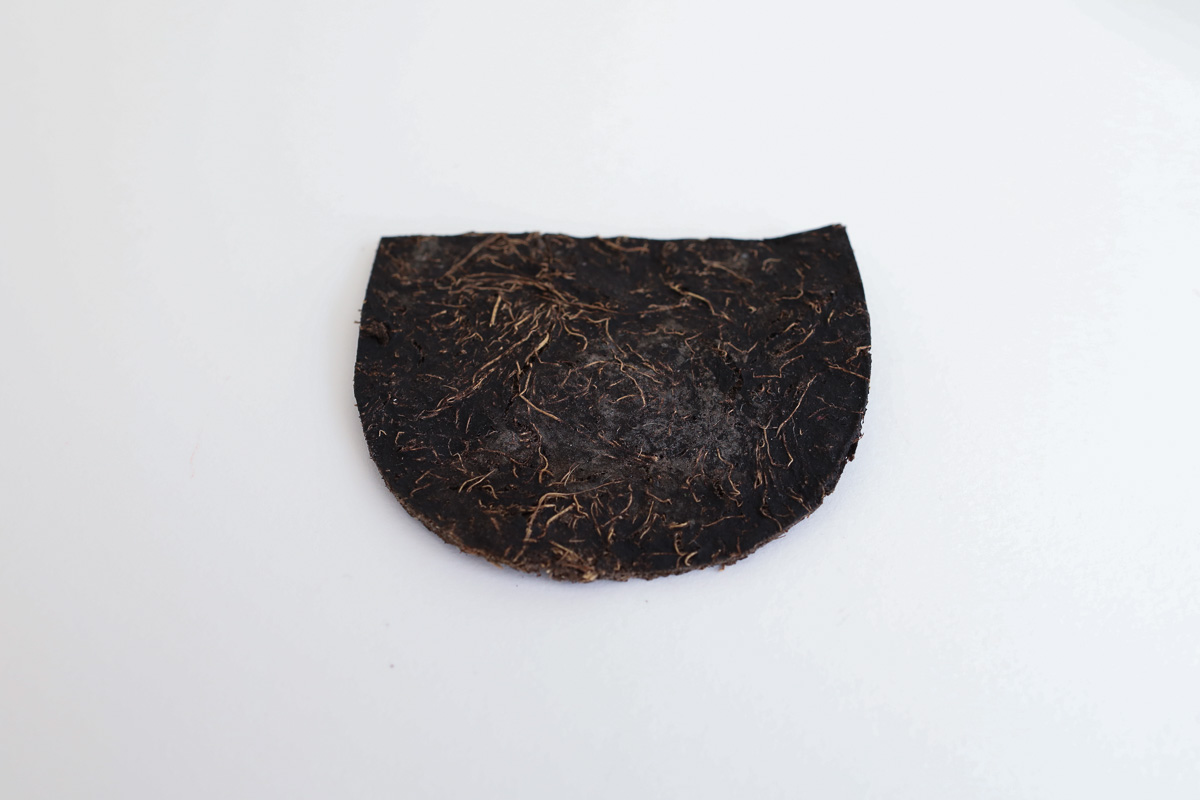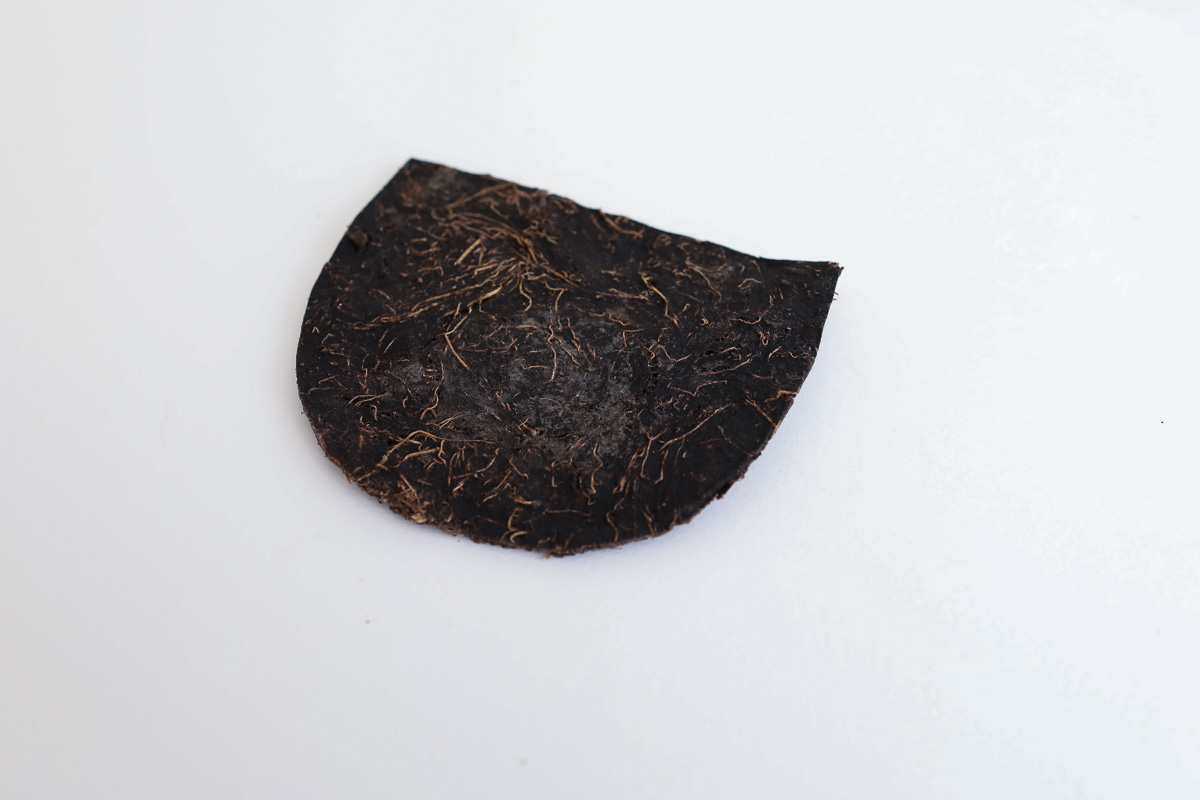- CLAY FROM BANANA PEELS
- Tactility & sound impression
- Description
- Physical form
- Fabrication time
- Ingredients
- Tools
- Yield before processing/drying/curing
- Method
- Drying/curing/growth process
- Process
- Variations on this recipe
- Cultural origins of this recipe
- This recipe draws together information from these other recipes
- Known concerns and contestations
- Sustainability tags
- Material properties
- Comparative qualities
- Technical and sensory properties
- About this entry
- Maker of this sample
- Environmental conditions
- Recipe validation
- Estimated cost (consumables) in local currency
- Copyright information
- Images of final product
CLAY FROM BANANA PEELS
Tactility & sound impression
Description
A fibrous, clay-like material made from banana peels
Physical form
Surfaces
Color without additives: dark brown with lighter strands of fibre
Fabrication time
Preparation time: 3 hours
Processing time: 1 week
Need attention: every day to alternate pressing and drying
Final form achieved after: 1 week
Ingredients
- banana peels - 7 pcs mush scraped out, stems chopped off, you can dry them while collecting. Once boiled they get sticky. The starch is the polymer, the fibres give strength to the material.
- white vinegar - 50 ml
- 1 tbsp soda ash - to rinse and break down the banana peel
- white vinegar (part two) - 30 ml
- glycerine - 15 gr plasticizer (to make it more flexible)
Tools
- Oven
- A blender
- A knife
- A pot
- A strainer
- A cheescloth or a clean towel
- A stack of books for pressing
- A flat surface
- Optional: baking paper and a rolling pin
- Optional: moulds
Yield before processing/drying/curing
Approx. 75 grams (when wet)
Method
-
Preparing the banana peels
- Remove the pulp if you haven't done so, and cut off the stems, they're very hard to puree.
- Cut the peels into smaller pieces
- Boil in water with 50 ml vinegar and soda ash for about 30 minutes or until totally soft. The smell will be very strong and the banana peels will be very sticky.
-
Puree and rest
- put the puree in a bowl of cold water, add 30 ml of vinegar and leave to soak for 2 hours.
-
Straining
- strain the puree in a strainer, puree again if it's still very rough
- then put in a cheesecloth or towel and press the majority of the water out.
- mix in the glycerine
- put it on a surface and flatten it (with a rolling pin, or with your hands). Keep it pressed under heavy objects (like books) for a couple hours.
-
Baking the clay
- then put the slab in the oven for 30 mins at 130 degrees Celcius
- Leave to air dry for 3 at least 3 days, alternate drying and pressing with a stack of books.
- Trim fraying edges with scissors before the slab is completely dry and hard.
Drying/curing/growth process
The air drying phase of at least three days is crucial here. The slab will still be very moist after the oven time. It will be fragile when you take it out but gets a lot stronger as it air dries.
- Mold depth (surfaces and solids) or diameter (strings): 5 mm
- Shrinkage thickness 20-30 %
- Shrinkage width/length 0-10 %
Shrinkage and deformation control
The slab doesn't shrink so much but it deforms a lot if you don't keep it pressed well before oven time and during the air drying phase.
Curing agents and release agents
None
Minimum wait time before releasing from mold
3 days
Post-processing
Keep an eye on it (even after a week). If it continues to curl up, keep it pressed for longer.
Further research needed on drying/curing/growth?
Not sure, the function of the vinegar and soda ash is not entirely clear and could be further reserached.
Process
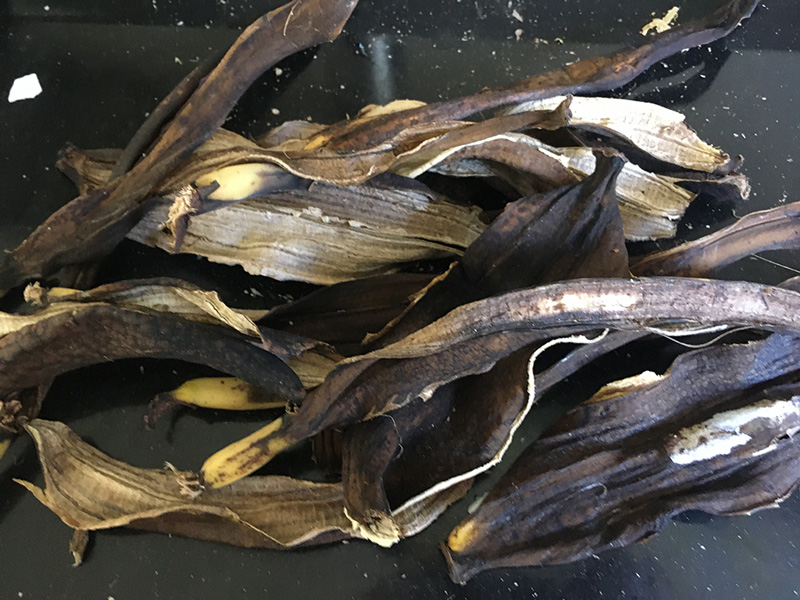 Collecting banana peels, Loes Bogers, 2020
Collecting banana peels, Loes Bogers, 2020
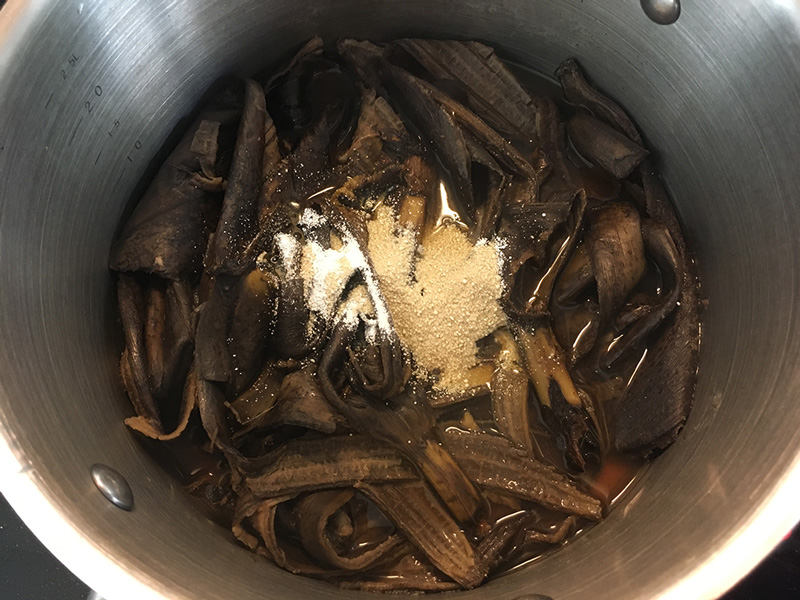 Boiling the peels with vinegar and soda ash (it's better to chop them first to help shorten the fibres), Loes Bogers, 2020
Boiling the peels with vinegar and soda ash (it's better to chop them first to help shorten the fibres), Loes Bogers, 2020
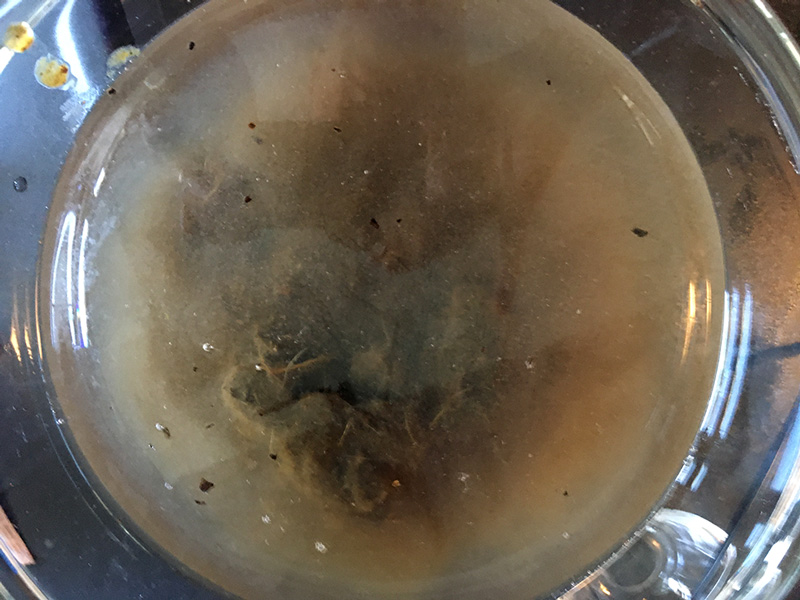 Soaking the blended peels in cold water with vinegar for 2 hours, Loes Bogers, 2020
Soaking the blended peels in cold water with vinegar for 2 hours, Loes Bogers, 2020
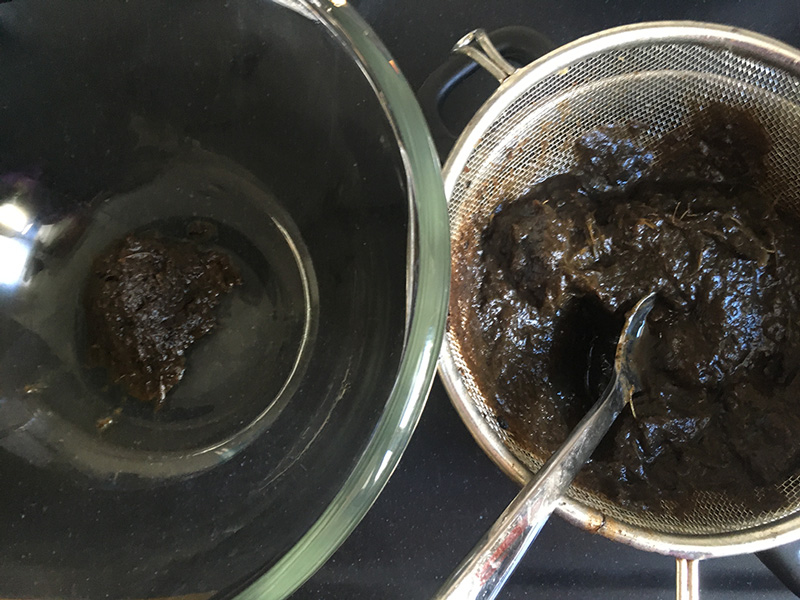 Straining, Loes Bogers, 2020
Straining, Loes Bogers, 2020
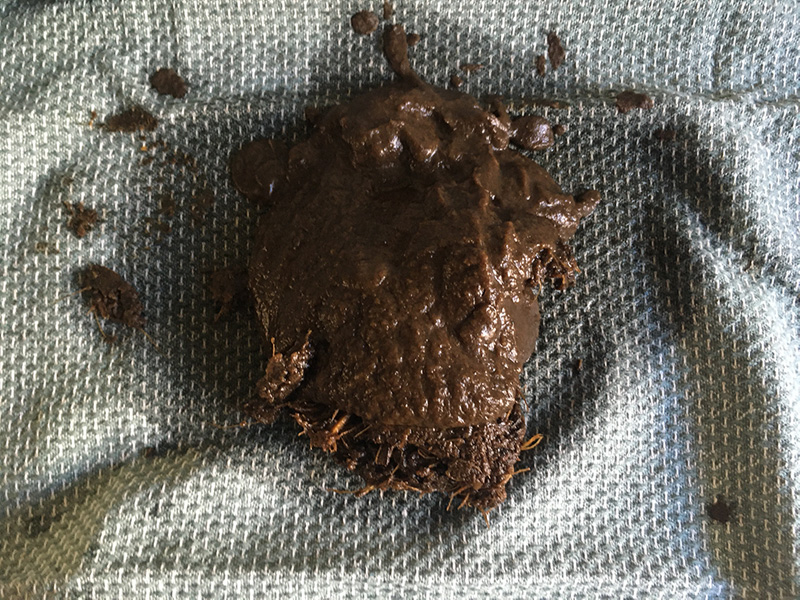 Squeezing the liquid out, Loes Bogers, 2020
Squeezing the liquid out, Loes Bogers, 2020
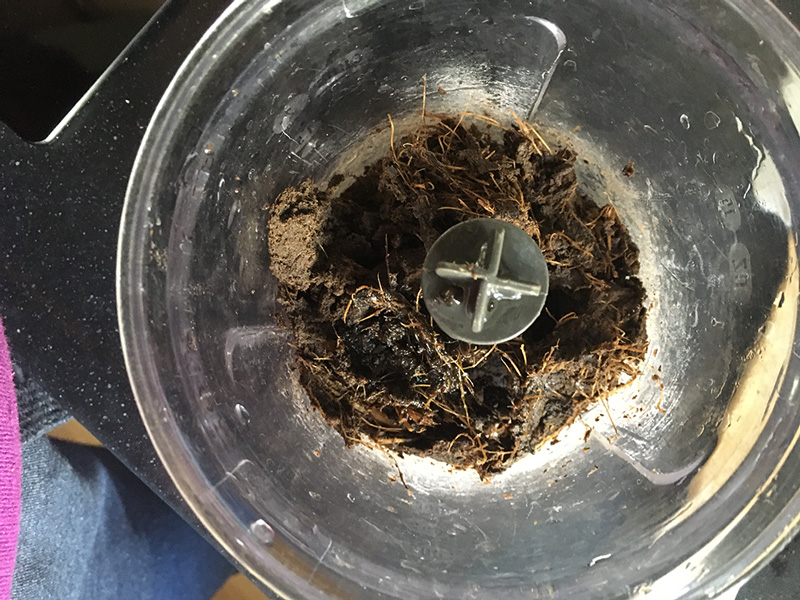 Blending again with some glycerine, Loes Bogers, 2020
Blending again with some glycerine, Loes Bogers, 2020
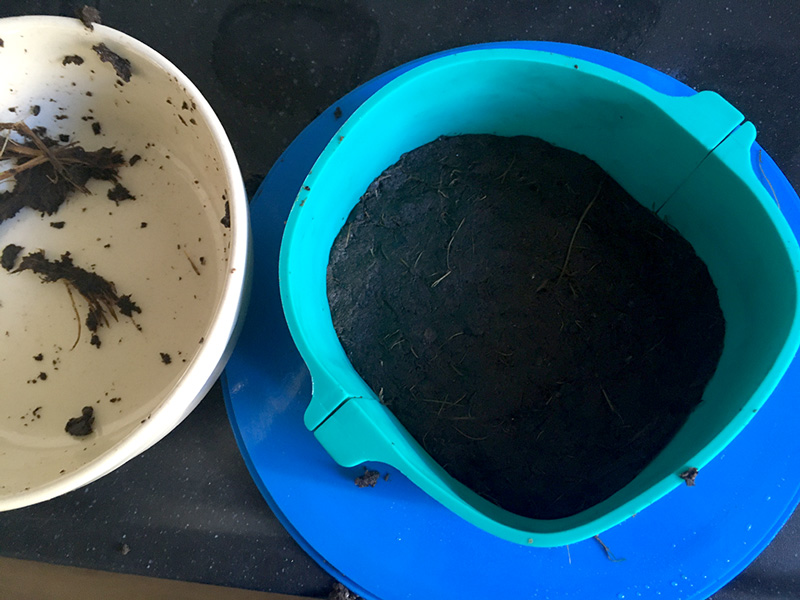 Pressing the clay into a mould for baking, Loes Bogers, 2020
Pressing the clay into a mould for baking, Loes Bogers, 2020
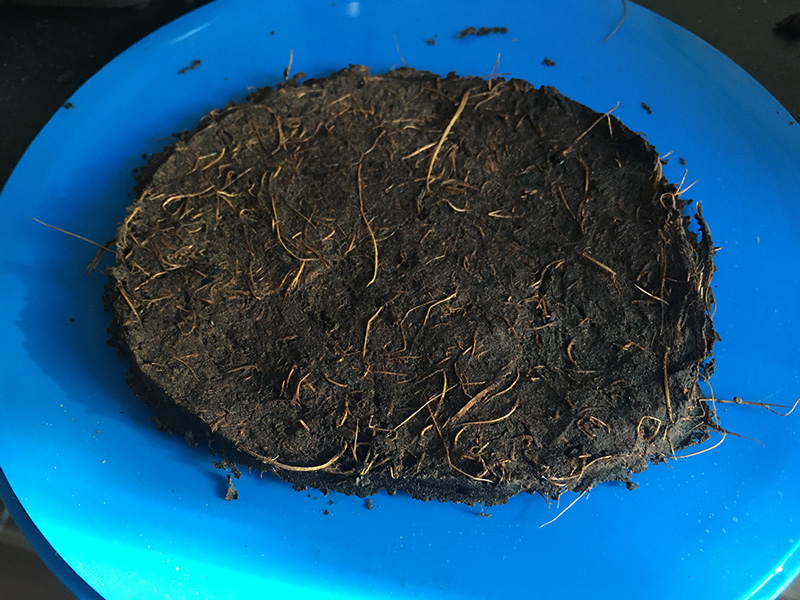 The top after pressing and baking, Loes Bogers, 2020
The top after pressing and baking, Loes Bogers, 2020
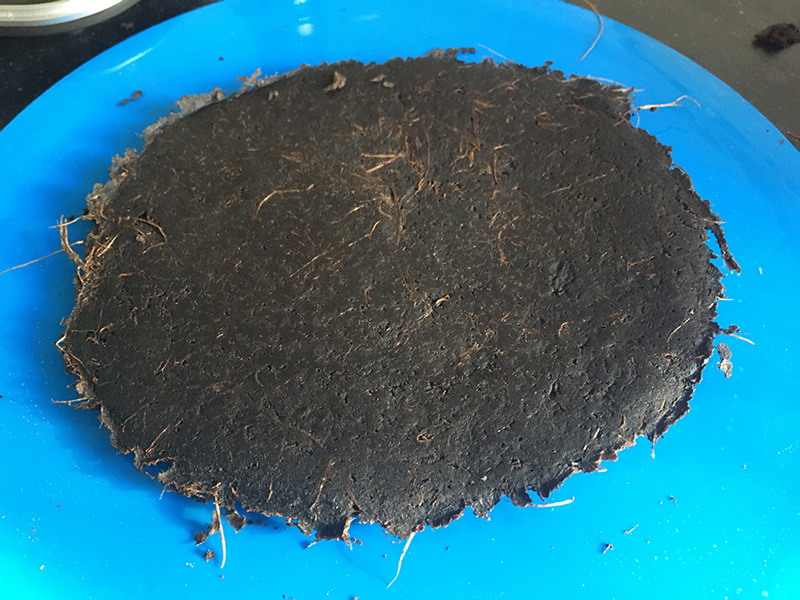 The bottom after pressing and baking, Loes Bogers, 2020
The bottom after pressing and baking, Loes Bogers, 2020
Variations on this recipe
- Use a 3D mould for to make 3D objects
- Make thicker slabs - or thinner
- Add less glycerine for more rigid slabs, more for flexibility
- Add in other biomass fillers (like egg shell powder, coffee grinds etc).
- Add co-polymer like cornstarch, it has been suggested that adding 4% cornstarch to the total weight of banana peel starch increases the tensile strength of the material (see also Sultan and Johari's article listed below).
- Others have spread the paste thinly onto a ceramic tile (substitute with a pizza stone perhaps?) and then baked. This would require processing the fibres into a finer paste.
- Research the use of sorbitol (an artificial sweetener made from potatoes or fruit) as a plasticizer to replace the glycerol. It is suggested to create different properties in the materials.
Cultural origins of this recipe
Unlike the fibres and starches in peels used here, the fibres of banana plants have a long history of being used to produce textiles. This banana textile crafts and industry is said to have developed first in the Phillipines, a country with a longstanding banana industry and banana textile crafts history. Especially the inner part of the banana bark is a desirable fibre that can be transformed into silk-like alternatives. The outer part of the bark results in rougher fibres and is commonly used to produce mats, ropes, or bags. India and other countries in Asia with large banana production facilities also produce banana fibres for textile.
This recipe departs from that heritage however, in that it doesn't use the fibres taken from the plant itself, but reuses the waste of the edible fruits of the plants: the peels. The main ingredient here is a waste product from the food industry. As such it is tied to other bioplastics made from biomass and food waste that have become increasingly popular in materials engineering and e.g. industrial design in recent years, and less related to the production of banana silk. Through a process of polymerization, the starch and the fibres in the peels are softened, pureed, formed and dried. It is technically a plastic, but has aesthetic properties that resemble clay. Recipes for polymerization with banana peels have gained attention in the last few years, mostly in academia, with recipes popping up in fields of engineering, design and crafts and even construction (banana peel powder can strengthen concrete for example). Some prominent references are listed below.
Needs further research? Yes
The use of banana peels as a resource is less well documented than that of the fibres of banana plants. Its origins could be further researched. The process, using soda ash and vinegar and its functions could be researched further.
This recipe draws together information from these other recipes
- Banana Bioplastic by Mattia Massetti (Sperim Design) on Youtube, 20 November 2018: link
and to a lesser extent the articles mentioned under "references".
Known concerns and contestations
In order for bananas (and their peels) to arrive to say, Europe they will have inevitably travels many many miles. The fact that they can be shipped while still unripe, and continue to ripen - for consumption - allows them to be transported by sea rather than air, which is seen as an advantage. As fruit waste is huge in affluent countries, there's likely to also be a lot of banana waste (further research needed), and peels may be acquired from businesses that process bananas at a large scale. One might still wonder whether the consumption exotic fruits should be reduced.
That said, agricultural production is not always done sustainably, and synthetic pesticides and/or harsh labour conditions can be issues anywhere in the world, whether a product is made from biomass, and/or food waste or not. The entire chain deserves our attention.
Sustainability tags
- Renewable ingredients: yes
- Vegan: yes
- Made of by-products or waste: yes
- Biocompostable final product: yes
- Re-use: needs further research but likely can be shredded and processed again and again.
Needs further research?: Yes, on reusability
Material properties
Comparative qualities
Although technically this would be considered a polymeer, the look and feel of this material is clay like and has a rough surfcae. Like a clay with fibres added to it. It smells very strong during cooking, much less after drying. It smells and feels a little similar to rubber, like a shoe sole but slightly earthier.
Technical and sensory properties
- Strength: strong
- Hardness: resilient
- Transparency: opaque
- Glossiness: matt
- Weight: light
- Structure: closed
- Texture: rough
- Temperature: medium
- Shape memory: high
- Odor: strong (a bit rubbery, less strong after drying)
- Stickiness: low
- Weather resistance: needs further research
- Acoustic properties: absorbing
- Anti-bacterial: needs further research
- Non-allergenic: needs further research
- Electrical properties: needs further research
- Heat resistance: high
- Water resistance: high
- Chemical resistance: needs further research
- Scratch resistance: high
- Surface friction: medium
- Color modifiers: none
About this entry
Maker of this sample
- Name: Loes Bogers
- Affiliation: Fabricademy student at Waag Textile Lab Amsterdam
- Location: Amsterdam, the Netherlands
- Date: 29-03-2020 - 05-04-2020
Environmental conditions
- Humidity: not sure
- Outside temp: 11-15 degrees Celcius
- Room temp: 18-22 degrees Celcius
- PH tap water: 7-8
Recipe validation
Has recipe been validated?
Not yet.
Estimated cost (consumables) in local currency
0,10 Euros, for a yield of one slab of approx. 10 x 10cm, 2 mm thick.
Copyright information
This is a variation on: - Banana Bioplastic by Mattia Massetti (Sperim Design) on Youtube, 20 November 2018: link
It is unclear what kind of copyrights apply, further research is required.
##References
- Bio-plastic (Generating Plastic From Banana Peels) by Manasi Ghamande et.al. International Conference on New Frontiers of Engineering, Management, Social Sciences and Humanities in Pune, India, 25 February 2018: link
- The Development of Banana Peel/Corn starch Bioplastic film: a Preliminary Study by Noor Fatimah Kader Sultan and Wan Lutfi Wan Johari in Bioremediation Science & Technology Research, Vol. 5, Nr 1, 2017: link
- Production of Bioplastic from Banana Peels by M.R. Gaonkar, Prashant Palaskar and Rishikesh Navandar in: Proceedings of the IIER International Conference, Hong Kong, 27-28 December 2017: link
- Banana Bioplastic by Mattia Massetti (Sperim Design) on Youtube, 20 November 2018: link
- Banana Fibre Extraction, Processing, Yarn Spinning & Weaving, by Textile TV on Youtube, 9 August 2018: link
- What is Banana Fabric? Properties, How It's Made and Where by Boris Hodakel for Sewport, 6 April 2020: link
- Are Bananas the new Building Material? by Construction Manager Magazine, 12 October 2017: link
- Analysis of Properties of Concrete Using Dried Banana Peel Powder as Admixture by Vishal Gadgihalli, Sindhu Shankar, S.C. Sharma, P. Dinakar in International Journal of Research Granthaalayah, 5(11), November 2017: pp. 351-354: link
Images of final product
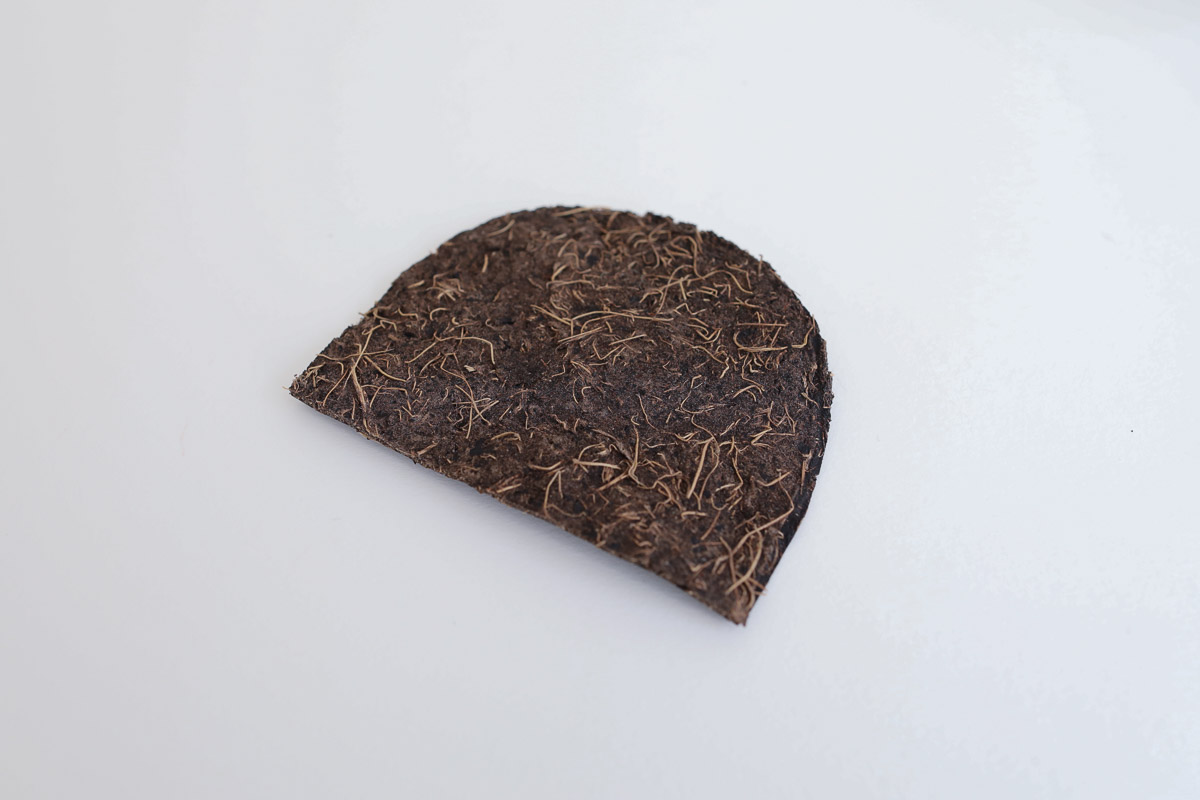 Banana peel clay, Loes Bogers, 2020
Banana peel clay, Loes Bogers, 2020
